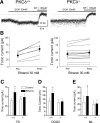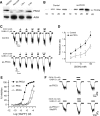Protein kinase Cdelta regulates ethanol intoxication and enhancement of GABA-stimulated tonic current
- PMID: 19005054
- PMCID: PMC2688726
- DOI: 10.1523/JNEUROSCI.3156-08.2008
Protein kinase Cdelta regulates ethanol intoxication and enhancement of GABA-stimulated tonic current
Abstract
Ethanol alters the distribution and abundance of PKCdelta in neural cell lines. Here we investigated whether PKCdelta also regulates behavioral responses to ethanol. PKCdelta(-/-) mice showed reduced intoxication when administered ethanol and reduced ataxia when administered the nonselective GABA(A) receptor agonists pentobarbital and pregnanolone. However, their response to flunitrazepam was not altered, suggesting that PKCdelta regulates benzodiazepine-insensitive GABA(A) receptors, most of which contain delta subunits and mediate tonic inhibitory currents in neurons. Indeed, the distribution of PKCdelta overlapped with GABA(A) delta subunits in thalamus and hippocampus, and ethanol failed to enhance tonic GABA currents in PKCdelta(-/-) thalamic and hippocampal neurons. Moreover, using an ATP analog-sensitive PKCdelta mutant in mouse L(tk(-)) fibroblasts that express alpha4beta3delta GABA(A) receptors, we found that ethanol enhancement of GABA currents was PKCdelta-dependent. Thus, PKCdelta enhances ethanol intoxication partly through regulation of GABA(A) receptors that contain delta subunits and mediate tonic inhibitory currents. These findings indicate that PKCdelta contributes to a high level of behavioral response to ethanol, which is negatively associated with risk of developing an alcohol use disorder in humans.
Figures






Similar articles
-
Binge ethanol exposure delays development of GABAergic miniature postsynaptic currents in septal neurons.Brain Res Dev Brain Res. 2004 Sep 17;152(2):199-212. doi: 10.1016/j.devbrainres.2004.06.017. Brain Res Dev Brain Res. 2004. PMID: 15351508
-
Sensitivity of GABAergic Tonic Currents to Acute Ethanol in Cerebellar Granule Neurons is Not Age- or δ Subunit-Dependent in Developing Rats.Alcohol Clin Exp Res. 2016 Jan;40(1):83-92. doi: 10.1111/acer.12940. Alcohol Clin Exp Res. 2016. PMID: 26727526 Free PMC article.
-
Functional consequences of GABAA receptor alpha 4 subunit deletion on synaptic and extrasynaptic currents in mouse dentate granule cells.Alcohol Clin Exp Res. 2008 Jan;32(1):19-26. doi: 10.1111/j.1530-0277.2007.00564.x. Epub 2007 Dec 7. Alcohol Clin Exp Res. 2008. PMID: 18070250
-
GABAA receptors in the thalamus: alpha4 subunit expression and alcohol sensitivity.Alcohol. 2007 May;41(3):177-85. doi: 10.1016/j.alcohol.2007.03.010. Epub 2007 May 23. Alcohol. 2007. PMID: 17521848 Review.
-
GABA(A) receptors as molecular sites of ethanol action. Direct or indirect actions?Curr Top Med Chem. 2002 Aug;2(8):869-85. doi: 10.2174/1568026023393426. Curr Top Med Chem. 2002. PMID: 12171577 Review.
Cited by
-
Signaling pathways mediating alcohol effects.Curr Top Behav Neurosci. 2013;13:87-126. doi: 10.1007/7854_2011_161. Curr Top Behav Neurosci. 2013. PMID: 21877259 Free PMC article. Review.
-
Ethanol reduces GABAA alpha1 subunit receptor surface expression by a protein kinase Cgamma-dependent mechanism in cultured cerebral cortical neurons.Mol Pharmacol. 2010 May;77(5):793-803. doi: 10.1124/mol.109.063016. Epub 2010 Feb 16. Mol Pharmacol. 2010. PMID: 20159950 Free PMC article.
-
Potentiation of Gamma Aminobutyric Acid Receptors (GABAAR) by Ethanol: How Are Inhibitory Receptors Affected?Front Cell Neurosci. 2016 May 6;10:114. doi: 10.3389/fncel.2016.00114. eCollection 2016. Front Cell Neurosci. 2016. PMID: 27199667 Free PMC article. Review.
-
1H, 13C and 15N NMR assignments of the C1A and C1B subdomains of PKC-delta.Biomol NMR Assign. 2011 Oct;5(2):125-9. doi: 10.1007/s12104-010-9283-0. Epub 2010 Dec 4. Biomol NMR Assign. 2011. PMID: 21132404 Free PMC article.
-
Alcohol dependence: molecular and behavioral evidence.Trends Pharmacol Sci. 2014 Jul;35(7):317-23. doi: 10.1016/j.tips.2014.04.009. Epub 2014 May 25. Trends Pharmacol Sci. 2014. PMID: 24865944 Free PMC article. Review.
References
-
- Borghese CM, Stórustovu S, Ebert B, Herd MB, Belelli D, Lambert JJ, Marshall G, Wafford KA, Harris RA. The delta subunit of gamma-aminobutyric acid type A receptors does not confer sensitivity to low concentrations of ethanol. J Pharmacol Exp Ther. 2006;316:1360–1368. - PubMed
-
- Bowers BJ, Owen EH, Collins AC, Abeliovich A, Tonegawa S, Wehner JM. Decreased ethanol sensitivity and tolerance development in gamma-protein kinase C null mutant mice is dependent on genetic background. Alcohol Clin Exp Res. 1999;23:387–397. - PubMed
Publication types
MeSH terms
Substances
Grants and funding
LinkOut - more resources
Full Text Sources
Other Literature Sources
Molecular Biology Databases
